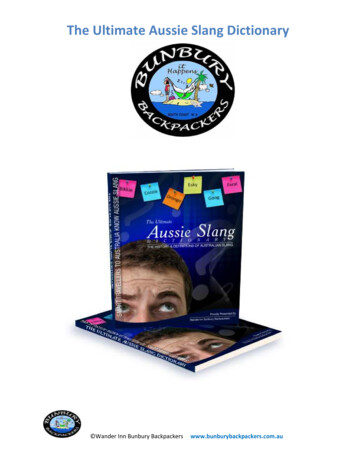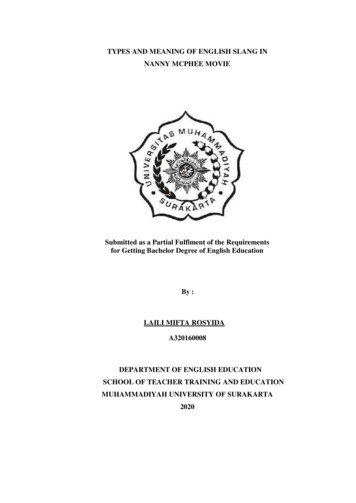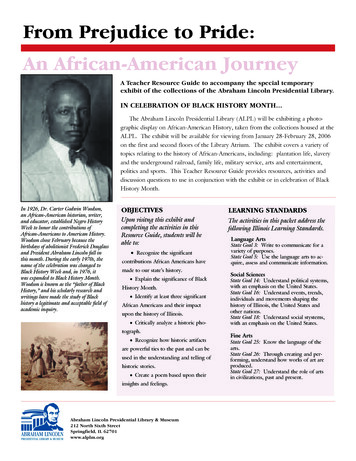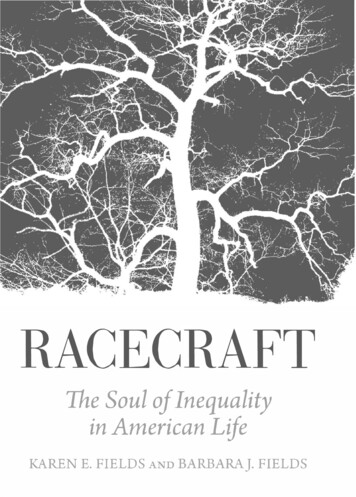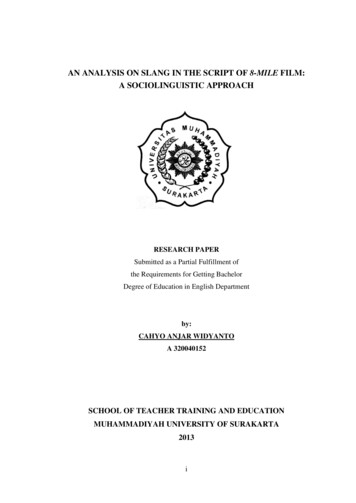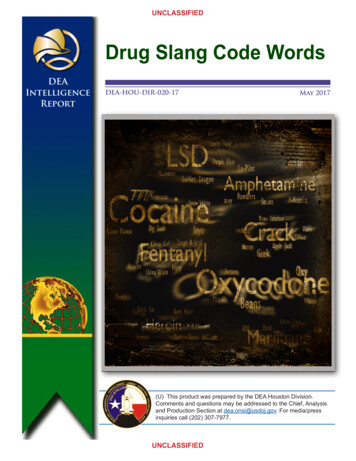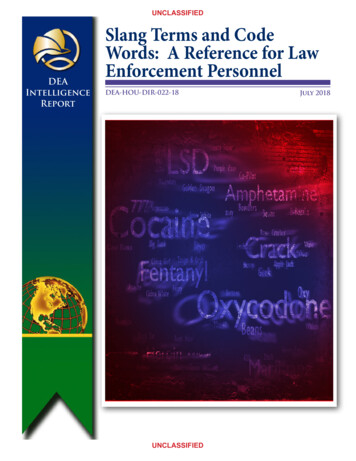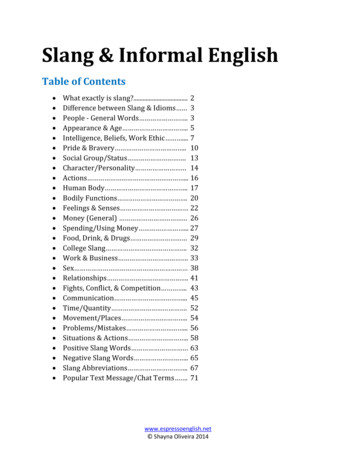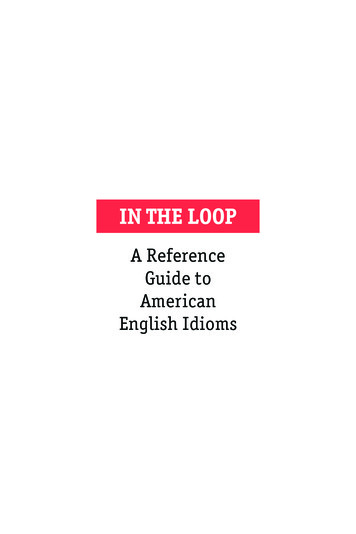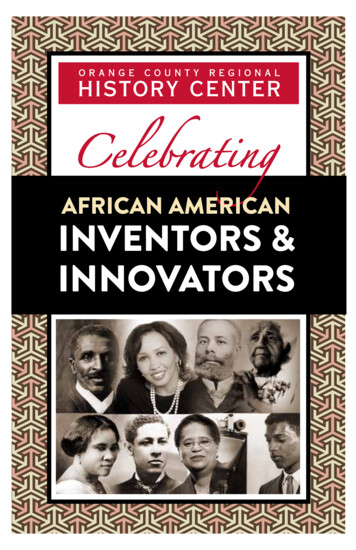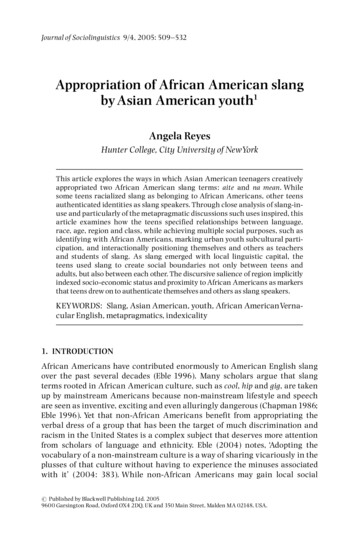
Transcription
Journal of Sociolinguistics 9/4, 2005: 509 532Appropriation of African American slangby Asian American youth1Angela ReyesHunter College, City University of NewYorkThis article explores the ways in which Asian American teenagers creativelyappropriated two African American slang terms: aite and na mean. Whilesome teens racialized slang as belonging to African Americans, other teensauthenticated identities as slang speakers. Through close analysis of slang-inuse and particularly of the metapragmatic discussions such uses inspired, thisarticle examines how the teens specified relationships between language,race, age, region and class, while achieving multiple social purposes, such asidentifying with African Americans, marking urban youth subcultural participation, and interactionally positioning themselves and others as teachersand students of slang. As slang emerged with local linguistic capital, theteens used slang to create social boundaries not only between teens andadults, but also between each other. The discursive salience of region implicitlyindexed socio-economic status and proximity to African Americans as markersthat teens drew on to authenticate themselves and others as slang speakers.KEYWORDS: Slang, Asian American, youth, African AmericanVernacular English, metapragmatics, indexicality1. INTRODUCTIONAfrican Americans have contributed enormously to American English slangover the past several decades (Eble 1996). Many scholars argue that slangterms rooted in African American culture, such as cool, hip and gig, are takenup by mainstream Americans because non-mainstream lifestyle and speechare seen as inventive, exciting and even alluringly dangerous (Chapman 1986;Eble 1996). Yet that non-African Americans benefit from appropriating theverbal dress of a group that has been the target of much discrimination andracism in the United States is a complex subject that deserves more attentionfrom scholars of language and ethnicity. Eble (2004) notes, ‘Adopting thevocabulary of a non-mainstream culture is a way of sharing vicariously in theplusses of that culture without having to experience the minuses associatedwith it’ (2004: 383). While non-African Americans may gain local social# Published by Blackwell Publishing Ltd. 20059600 Garsington Road, Oxford OX4 2DQ, UK and 350 Main Street, Malden MA 02148, USA.
510REYESprestige through peppering their speech with African American slang terms,they do so without suffering the daily experiences with discrimination thatplague the lives of manyAfrican Americans.While there has been some work examining the use of African Americanslang by European Americans, studies of its use byAsian Americans are extremely scarce. Analyzing how Asian Americans adopt African American slangbrings a fresh perspective to this body of research because unlike EuropeanAmericans, Asian Americans share racial minority status with AfricanAmericans. Yet unlike other minority groups, Asian Americans are uniquelypositioned by contradicting U.S. racial ideologies which, although still largelyoperating along a black white racial dichotomy, have managed to carve outpositions for Asian Americans as ‘forever foreigners’ and ‘honorary whites’(Tuan 1998). A third stereotype has emerged that positions some AsianAmerican groups particularly South-east Asian refugee youth as problemminorities who have fallen prey to stereotypes traditionally assigned toAfrican Americans (e.g. Bucholtz 2004; Lee 2001; Reyes forthcoming). Unlikemiddle-class European American youth, low-income South-east AsianAmerican teenagers like those in this study are often positioned moreclosely to the African American experience based on a shared socio-economicand minority status. Asian American cross-racial though not cross-minority use of African American slang offers new viewpoints on the various discursivepractices available to non-whites as they establish their identities relative toAfrican American linguistic styles.Much research on African American linguistic styles is centered on AfricanAmerican Vernacular English (AAVE) and its complex histories, structures,uses and politics (e.g. Baugh 1983; Labov 1972; Mufwene, Rickford, Bailey andBaugh 1998). The central argument of this work is that AAVE is not ‘bad’English; rather, AAVE has its own rule-governed system comprised of phonological, morphological, syntactic and discourse features. While varieties ofLatino English have also been widely studied along similar models of AAVEresearch (e.g. Fought 2003; Metcalf 1979; Penfield and Ornstein-Galicia 1985),the language practices of Asian Americans have only disrupted dominantsociolinguistic paradigms that presume a kind of one-to-one mapping betweena linguistically distinct form of English and a racially distinct group (Reyesand Lo 2004). Although evidence for an ‘Asian American English’ akin toAAVE or Latino English has generally been inconclusive (e.g. Hanna 1997;Mendoza-Denton and Iwai 1993; Spencer 1950; Wolfram, Christian andHatfield1986), this does not prevent Asian Americans from drawing on availablelinguistic resources to construct their identities (Bucholtz 2004).Yet borrowinglinguistic resources to do identity work inevitably raises sensitive issues,particularly when speakers cross racially-defined linguistic lines to do so.The question of howAsian Americans use AAVE features in the constructionof their identities may be a question of ‘styling the other’ (Rampton 1999; seealso Rampton 1995a on ‘language crossing’), which is concerned with the# Blackwell Publishing Ltd. 2005
APPROPRIATION OFAFRICAN AMERICAN SLANG511‘ways in which people use language and dialect in discursive practice to appropriate, explore, reproduce or challenge influential images and stereotypes ofgroups that they don’t themselves (straightforwardly) belong to’ (Rampton1999: 421). Many scholars argue that such styling practices across racialgroups are bound up with complex tensions involving racialization and appropriation (e.g. Bucholtz 2001; Hewitt 1982; Rampton 1995a). If racializationinvolves linking a way of speaking to a distinct racial formation, appropriationentails crossing into the linguistic variety which has been formulated as thatof the racial other, and exploiting it for new uses and effects. In seeming contrast, the concept of authentication (Bucholtz 2003; Coupland 2001) can beused to explore the ways in which linguistic styles are discursively constitutedas one’s own ‘authentic’ speech. As part of Bucholtz and Hall’s (2004) ‘tacticsof intersubjectivity’ model through which language and identity can be examined, authentication refers to the processes by which people actively constructan identity based on ideas of genuineness or credibility. The practices of crossracial users of AAVE who formulate AAVE as their own variety, for example,exhibit this process of authentication. In this article I consider how processesof racialization, appropriation and authentication are integral in examiningthe ways in which speakers actively construct their identities through discursively constituted links between linguistic styles and categories of persons.While there is a small body of work on European Americans crossing intoAAVE (e.g. Bucholtz 1997, 1999; Cutler 1999; Hatala 1976; Labov 1980;Sweetland 2002), even less exists on AAVE use by Asian Americans (but seeBucholtz 2004; Chun 2001; Lo 1999; Reyes 2002). While some EuropeanAmerican users of AAVE are met with suspicion because of their unsystematicperformance of AAVE features (e.g. Bucholtz 1997, 1999; Cutler 1999), otherscan be authenticated as AAVE speakers within local speech communities (e.g.Sweetland 2002). Though authenticated use of AAVE byAsian Americans hasyet to be documented, its occurrence is not altogether unlikely. However,instead of passing as fluent AAVE speakers or trying to ‘act black’, manyAsianAmericans use AAVE features to lay claim to participation in an urban youthstyle (e.g. Bucholtz 2004; Chun 2001), much like most European Americansdo (e.g. Bucholtz 1997; Cutler 1999).As for Asians in the diaspora outside of the United States crossing into blackspeech styles, Rampton’s (1995a) work remains a seminal account of the socialmeanings achieved when Asian immigrants cross into Creole, which is spokenprimarily by Afro-Caribbean immigrants in England. Since youth admiredCreole, which ‘stood for an excitement and excellence in vernacular youthculture’ (Rampton 1995b: 506), Rampton (1995a) argues that such practicesclosely intertwined the speakers (Panjabi youth) with what they spoke(Creole), signaling favorable evaluations of Creole. Though Asian immigrantsare not the main focus of Hewitt (1986), he similarly finds that because of theprestige of British Jamaican Creole, ‘Asian teenage boys were occasionallymembers of black friendship groups and used creole with their black friends.# Blackwell Publishing Ltd. 2005
512REYESBlack youth culture was apparently felt to be so attractive an option for someAsian boys that they even artificially curled their hair, wore Rasta colours andattempted to ‘‘pass’’ for black’ (1986: 195). As is also common in the UnitedStates, both Hewitt (1986) and Rampton (1995a) find that many Asianimmigrants associate with black youth culture, creating closer ties betweenAsian and black identities through language and other semiotic means.Drawing on four years of ethnographic and video data at an Asian Americanteen video-making project, this article takes a linguistic anthropologicalapproach to discourse analysis to explore the ways in which South-east AsianAmerican teenagers creatively appropriated two African American slangterms: aite (‘all right’) and na mean (‘do you know what I mean?’).2 These twoslang expressions, discussed in further detail below, were chosen as the focusof this study because they were frequently used and discussed by the teens,and because they are commonly perceived as emerging from AfricanAmerican culture. Yet while some teens racialized slang as belonging toAfrican Americans, other teens authenticated identities as slang speakers.Through close analysis of slang-in-use and particularly of the metapragmaticdiscussions such uses inspired, this article examines how the teens specifiedrelationships between language, race, age, region and class, while achievingmultiple social purposes, such as identifying with African Americans, marking urban youth subcultural participation, and interactionally positioningthemselves and others as teachers and students of slang. As slang emergedwith local linguistic capital, the teens used slang to create boundaries notonly between teens and adults, but also between each other. Furthermore, thediscursive salience of region implicitly indexed socio-economic status andproximity to African Americans as markers that teens drew on to authenticatethemselves and others as slang speakers. By examining the ways in whichAsian American youth appropriated African American slang, this articleoffers new perspectives on the discursive practices available to non-black yetalso non-white speakers as they construct their identities relative to AfricanAmerican styles.2. METAPRAGMATICS AND INDEXICALITY OF SLANG-IN-USEEble (1996) describes slang as ‘an ever changing set of colloquial words andphrases that speakers use to establish or reinforce social identity or cohesiveness within a group or with a trend or fashion in society at large’ (1996: 11).Since non-mainstream culture and music are particularly influential insetting trends, young people, especially, adopt slang created by AfricanAmericans who dominate the entertainment world (Chapman 1986). As slangis associated with signaling coolness and engagement in youth culture, it hasalso been viewed as signifying resistance to established structures of power.Sledd (1965), for example, states that ‘to use slang is to deny allegiance to the# Blackwell Publishing Ltd. 2005
APPROPRIATION OFAFRICAN AMERICAN SLANG513existing order’ (1965: 699).Yet slang does not always mark resistance nor doessuch resistance always manifest itself in a binary division between ‘society’and ‘anti-society’ (Halliday 1976). Using slang to divide youth identities isoftentimes more important to adolescents than using slang to separate youthsubcultures from the dominant mainstream (Bucholtz 2001).While slang is commonly understood as ephemeral and informal vocabulary, researchers have focused more on identifying slang by its effects, ratherthan by its form or meanings (Eble 2004). Given this focus on communicativeeffect, which is contingent on multiple contextual factors in any interactionalinstance of slang use, there is no precise formula for knowing if a particularterm or phrase qualifies as slang. Thus rather than marking a clear lexicalterritory, slang describes a fluid range of words and expressions that locatesits users within some social terrain. Similar to how the concept of ‘style’ hasbeen approached by many sociolinguists (e.g. Bell 1984; Coupland 1985, 2001;Eckert and Rickford 2001), slang should not be defined by its internalinventory, but by how principles of differentiation organize the relationships and distinctiveness between slang and its alternatives (cf. Irvine 2001).This article is thus primarily concerned with how slang emerges withina contrastive system of discursive options and produces various socialmeanings and effects linked to issues of race, appropriation, andauthentication.Although work on slang has emerged over the past few decades, only a smallnumber of studies have moved beyond methodological approaches that relyalmost exclusively on questionnaires and elicited definitions of slang terms.Yet the process of construing the effects of slang should be less interested inthe actual slang terms themselves, and more interested in how slang emergesin interaction. By relying on reports of slang usage rather than analyzingslang use, researchers may be accessing ideologies of slang but not the practicesof slang (Bucholtz 2001). As researchers move slang-in-use to the center ofinquiry, they may discover implicit discursive strategies that construct additional meanings and functions of slang that are missed by more traditionalapproaches that rely solely on slang definitions at face value.Such examinations of how slang emerges in interaction can access nativemetapragmatic stereotypes about slang (Agha 1998, 2001). That is, researchers can examine the details of interaction to discover the stereotypes that areinvoked and linked to the use of slang in particular interactional contexts.These stereotypes emerge through denotationally explicit and implicitmetapragmatic evaluations (Silverstein 1976, 1993). That is, sometimes thestereotypes are stated explicitly by interactants and sometimes theyare accomplished implicitly through linguistic patterns that reveal the subtlemeanings and evaluations that participants construct for slang.To decipher the metapragmatics of slang, researchers can analyze indexicalpatterns in interaction. Although the literal meaning of a slang term is somewhat stable, its indexical value is not nearly as fixed. One referential value of# Blackwell Publishing Ltd. 2005
514REYESthe slang term cool, for example, is basically ‘good’, an adjective that indicates apositive assessment of some entity or practice. How the use of cool is indexicalof a type of personhood that is set in social and cultural relation to the speakerand audience, however, is indecipherable without appeal to the situation ofutterance. Like pronominal indexicals, such as ‘they’and ‘we’, whose meaningsare reliant on their occasion of use, slang terms also rely partly on surroundingcontext for their meaningfulness, while making salient particular aspects ofcontext (Benveniste 1971[1954]; Peirce 1932; Silverstein 1976). For example,while uttering cool can signal participation in youth culture when usedcasually by a teenager, it can conversely signal exclusion from youth culturewhen used awkwardly by an adult.Thus, slang can achieve multiple meanings and effects depending on contextual factors, such as who utters it, who is listening, in what situations, forwhat purposes, and so on. In this article I analyze how the Asian Americanteens used African American slang, a practice through which indexical linksmay run wild, possibly functioning to reproduce, challenge or redefine thesocial and interactional effects of slang. Coupling ethnographic data of participant perspectives with the close analysis of indexical patterns in interaction,I examine the implicit meanings and effects that are most likely achievedthrough the use of slang.3. SETTING AND PARTICIPANTSThis article is part of a four-year (1999 2002) ethnographic and discourseanalytic study of an Asian American teen video-making project at the AsianArts Initiative, a community arts organization located near Philadelphia’sChinatown.3 This project, which engaged a new group of about 15 teenagerseach year, met weekly from February to June. Teens, with the help of adultartists and volunteers, critically discussed issues relevant to their lives andcommunities, created a script based out of these discussions, then filmedand edited a 15-minute video that reflected their real-life experiences andperspectives. These videos were then screened at conferences, film festivals,community organizations, and schools. Over the years I was a volunteerand coordinator of the video-making project, and also a staff member of theAsian Arts Initiative. Data collection methods included participant observation,fieldnotes, interviews, and audio and video recording of interactions at projectsessions and video screenings.Most of the teens and their families immigrated from Cambodia, Laos andVietnam to poor urban neighborhoods in Philadelphia. While the majority ofteens were second generation, meaning they were American-born to foreignborn parents, the rest of the teens would be considered ‘1.5 generation’(Rumbaut and Ima 1988), as they were born in South-east Asian countries orin refugee camps or processing centers in Thailand or the Philippines then# Blackwell Publishing Ltd. 2005
APPROPRIATION OFAFRICAN AMERICAN SLANG515immigrated to the United States before adolescence, and in most cases beforethe age of five. According to the ‘segmented assimilation’ model by Portes andZhou (1993), rather than assimilating to the dominant white majority in theUnited States, several teens in this study were traveling the second trajectory:acculturation to socially and economically marginalized minority communities.Like many immigrant minorities settling in poor urban areas across the UnitedStates, most of the teens at the video-making project identified more with theexperiences of low-income African Americans than with those of the whitemainstream. Since their neighborhoods and schools were multi-ethnic thoughpredominantly African American, the Asian American teens had more contactwith African Americans than European Americans. Participating heavily inhip hop culture, the vast majority of teens wore clothing, accessories, make-upand hair styles popular among African American youth, and many of the maleteens practiced breakdancing, graffiti art, spinning records, rapping and R&Bsinging at the video-making project and in their neighborhoods.Not only did several teens embrace social practices linked to AfricanAmericans in the formation of their identities, they also incorporated linguistic features linked to African Americans in their speech. In discourse excerptstaken from Reyes (2002, 2004) and from this article, the teens produced thefollowing linguistic features often said to be restricted to AAVE: copula ellipsis(e.g. ‘yo yo he Cambo’, ‘it like’, ‘you still Philly’, ‘they coming up’); absenceof third person present tense (e.g. ‘he know how to protect himself’, ‘he tryto come’, ‘she look kinda aite’); and negative concord (e.g., ‘they don’t knownothing’, ‘you don’t got no problem’). Although it may be the case that a fewteens spoke AAVE systematically, it is more accurate to characterize the speechof the majority of the teens as a hybrid variety that frequently incorporated features of AAVE as well as features of Mainstream American English (MAE) andof Vietnamese, Khmer (Cambodian), Lao or other home languages of the teens.The teens who did not take on lifestyles and speech practices associated enotresidinginpoorneighborhoods, but in working-class or middle-class areas predominated by EuropeanAmericans. These teens were also the ones who tended to be ridiculed or at theveryleast socially marked for their self- orother-identified incompetence in slang.4. AITE AND NA MEANThrough morphological processes of word formation, the phrases ‘all right’and‘do you know what I mean?’ produce, respectively, the slang expressions, aiteand na mean. In conjunction with phonological modifications, word blendingforms aite [a i?t] (also spelled, for example,‘aight’, ‘aiight’, the latter iconicallyorthographizing vowel lengthening), and word blending and clipping form namean [na65mi?n] or [nja65mi?n] (also spelled, for example,‘nya mean’,‘nameen’).Similar to the various functions of the expressions ‘all right’ and ‘do you know.# Blackwell Publishing Ltd. 2005
516REYESwhat I mean?’ in MAE, aite was often used by the teens as an adjective (e.g.‘shelook kinda aite’), while both aite and na mean were frequently used as discoursemarkers drawing interactants into seemingly shared meanings and stancesby, for example, seeking agreement, comprehension or attention (for example:‘I got this idea, aite?’; ‘it’s just run down, na mean?’) (cf. Schiffrin 1987). Aiteand na mean are commonly recognized as having emerged from AfricanAmerican culture in the past decade or so, and are often still considered to bespoken primarily by African Americans. Yet any potential racial marking ofthese slang expressions relies less on their pragmatic function and more on theirphonetic contour and contextual placement, as will be shown below.I argue that aite and na mean are slang terms and not simply phonologicalvariants or pragmatic particles since they constitute alternatives to the conventional expressions ‘all right’and ‘do you know what I mean?’. That is, aite andna mean are often deliberatelychosento send social signals: for example, to conveyan informal or flippant attitude or to identify with a trend or social group. A similar logic supports the view of diss ‘disrespect’as a slang expression as well: thoughsome might argue that diss as well as aite and na mean are merely clippedwords, Eble (2004) recognizes diss as a slang term because of its social force.Over all four years of the video-making project, several teens frequently usedaite and na mean, among other African American slang expressions. Anh(Vietnamese-Cambodian-Chinese American female), Sokla and Bao (CambodianAmerican males) for example, regularly said aite and na mean in everyday interaction.4 There were some teens, however, who rarely used these slang terms.These teens typically lived in predominantly white, middle-class neighborhoods on the outskirts of urban Philadelphia. Anh, Sokla, Bao and severalothers who habitually used aite and na mean resided in poor neighborhoods inSouth Philadelphia with large African American populations.Yet often Anh, Sokla and Bao’s performances of slang were linguisticallymarked. For example, as Sokla was preparing to appear on camera momentsbefore a video shoot, he repeated na mean numerous times before the camerarolled, as if he needed to practice his delivery of this slang phrase. Likewise,Anh sometimes paused before she said na mean; and a few times Anh said ‘allright, aite’as if repairing ‘all right’ by immediately following it with aite. Theseteens may have been deliberately trying to speak African American slang, andthus deliberately trying to display a self-image that linked themselves moreclosely to African American culture or urban youth identity (cf. Eble 2004).Thus African American-inspired youth culture emerged with local prestige asmany teens admired and aspired to it through their linguistic choices, as wellas through their music, clothing and other lifestyle practices.Yet by rehearsingAfrican American slang and hesitating before speaking it, some teensconstructed slang as a more forced aspect of their speech repertoires.# Blackwell Publishing Ltd. 2005
APPROPRIATION OFAFRICAN AMERICAN SLANG5175. RACIALIZATION OF SLANGThese next few sections analyze how the teens racialized slang or authenticated identities as slang speakers. This first discourse excerpt from a projectsession of the video-making project in 2002 reveals how the Asian Americanteens directly linked ‘slang’ to ‘ghettoness’, and later racialized the use of slangas ‘black’ speech. In this interaction, Macy (Vietnamese American female) istrying to teach Will (Chinese American male) how to speak slang, specificallythe phrase na mean. Anh (Vietnamese-Cambodian-Chinese American female)and Van (Vietnamese American female) also enter the conversation.Excerpt 151 Macy: say na mean (.)Will [come on2 Van:[I can’t talk slang3 Macy: you can’t?4 Will:what’s slang5 Anh:[slang6 Macy: [sla::ng7 Will:oh what’s slang oh- oh sla::ng8 Van:except if I’m really mad9 Will:[na mean (.) na mean10 Macy: [hmm hmm hmm the ghettoness comes out11 Van:heh heh yes heh hehIn this interaction slang becomes metapragmatically equated with anger andghettoness while a social boundary based on slang competency is constructed tosetVan andWill apart from Macy and Anh.Van, who‘can’t talk slang’ (line 2), andWill, who asks ‘what’s slang?’ (line 4) stand in contrast to both Macy, who modelsna mean forWill (line1), and Anh, who responds inunison with Macy by repeatingthe word ‘slang’ (lines 5 and 6) as if in disbelief that Will does not even knowthe term.Van goes on to say that she can talk slang but only if she is ‘really mad’(line 8). Macy, then, explicitly links speaking slang to‘ghettoness’ (line10), whichlike na mean, is another slang term popularized byAfrican American culture.65.1 Dual indexicalityTwo weeks later, I asked Van what she meant when she said that she onlyspeaks slang when she is angry.Van said that when she is angry, she wants tobe more ‘scary’or ‘mean’. She then said:Excerpt 212Van:it makes me feel ‡black‡, or at least South PhillyTaking excerpts (1) and (2) together, ‘slang’ becomes discursively linked tobeing ‘mad’, ‘ghetto’, ‘black’ and ‘South Philly’. Van lowered her voice to awhisper when she said the word ‘black’ to me (line 12), which might indicate# Blackwell Publishing Ltd. 2005
518REYESthat Van did not want to be overheard, as if it was embarrassing or wrong tosay. Yet not only does Van racialize slang as belonging to African Americans,she also regionalizes it as South Philadelphia speech. Van, who did not live inSouth Philadelphia, located slang as a dialect of this area, which was largelyAfrican American. Her explicit reference to South Philadelphia elucidates thatit was place of residence but also class and race that distinguishes the twogroups of teens: slang incompetent Van and Will, who lived in middle-classneighborhoods on the outskirts of Philadelphia, and slang competent Macyand Anh, who lived in poor neighborhoods in South Philadelphia.That slang makes Van ‘feel black’ reveals how her racialization and appropriation of slang relied on ‘dual indexicality’ (Hill 1995; Ochs 1990). By usingslang to directly index herself as tough, Van reaped the benefits of the stereotype of the aggressive African American portrayed in popular culture asviolent, criminal and deviant (Ronkin and Karn 1999; van Dijk 1987).Although Van may draw on the stereotype of violence out of admiration, shealso indirectly indexed African Americans negatively by reproducing thestereotype.Van profited from the effects of her racialized linguistic resource asshe appropriated the local social capital linked to an imagined formidableAfrican American from South Philadelphia.Yet while the linguistic appropriation allowed her to construct a tough identity for herself, it did not require Vanto experience any other aspects of being African American that are lived everyday (Smitherman 2000). Although such language crossing practices allowspeakers to transgress fluid linguistic, ethnic and cultural boundaries, Vanrevealed how these practices can also reinforce social hierarchies and racialideologies in everyday interaction (Rampton 1999).5.2 Triple indexicalityThrough racializing and appropriating slang, Van relied on dual indexicalitywhile other teens, I argue, relied on triple indexicality not only to reflect positivelyon the borrower and negatively on the borrowee, but also to construct alliancesbetween Asian Americans and African Americans. Chun (2001), in her study ofJin, a Korean American male who uses imagined AAVE and African Americanslang terms, finds three such effects. First, Jin reproduces stereotypes of hyperheterosexual African American masculinity through his use of AAVE slangterms, such as booty, which emphasizes the objectification of female bodies.Second, through his appropriation of African American maleness, Jin uses AAVEto negotiate his Korean American male identity by challenging stereotypes ofAsian American men as passive and sexless. Third, Jin appropriates AAVE slangterms, such as whitey, to criticize European American domination. This lastindexical effect creates an alliance between Asian Americans and AfricanAmericans based on shared discrimination as people of color.Like Jin, Sokla (Cambodian American male) metapragmatically constructedan explicit alliance between African Americans and Asian Americans but,# Blackwell Publishing Ltd. 2005
APPROPRIATION OFAFRICAN AMERICAN SLANG519unlike Jin, the alliance only worked with a certain kind of Asian American: theOther Asian. Sokla often disting
a linguistically distinct form of English and a racially distinct group (Reyes and Lo 2004). Although evidence for an ‘Asian American English’ akin to AAVE or Latino English has generally been
